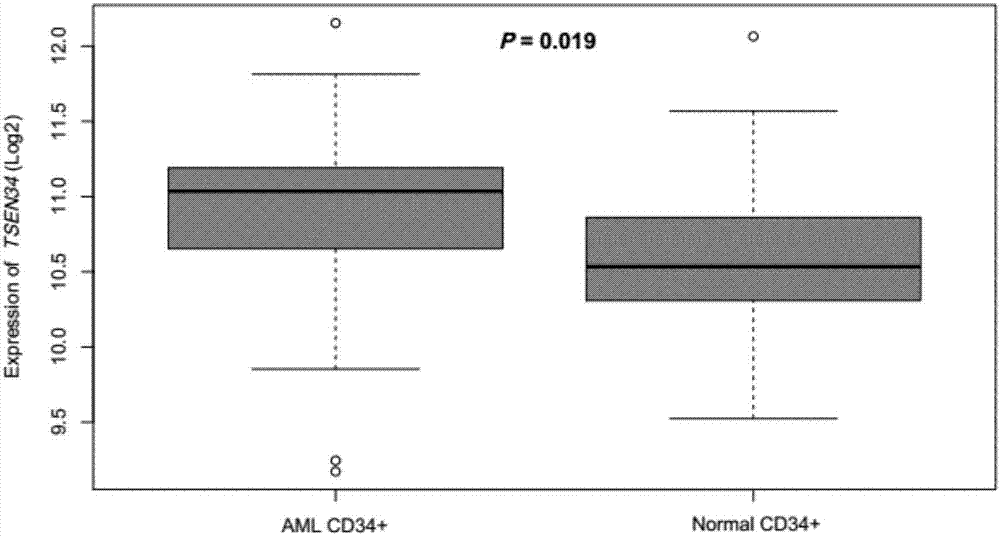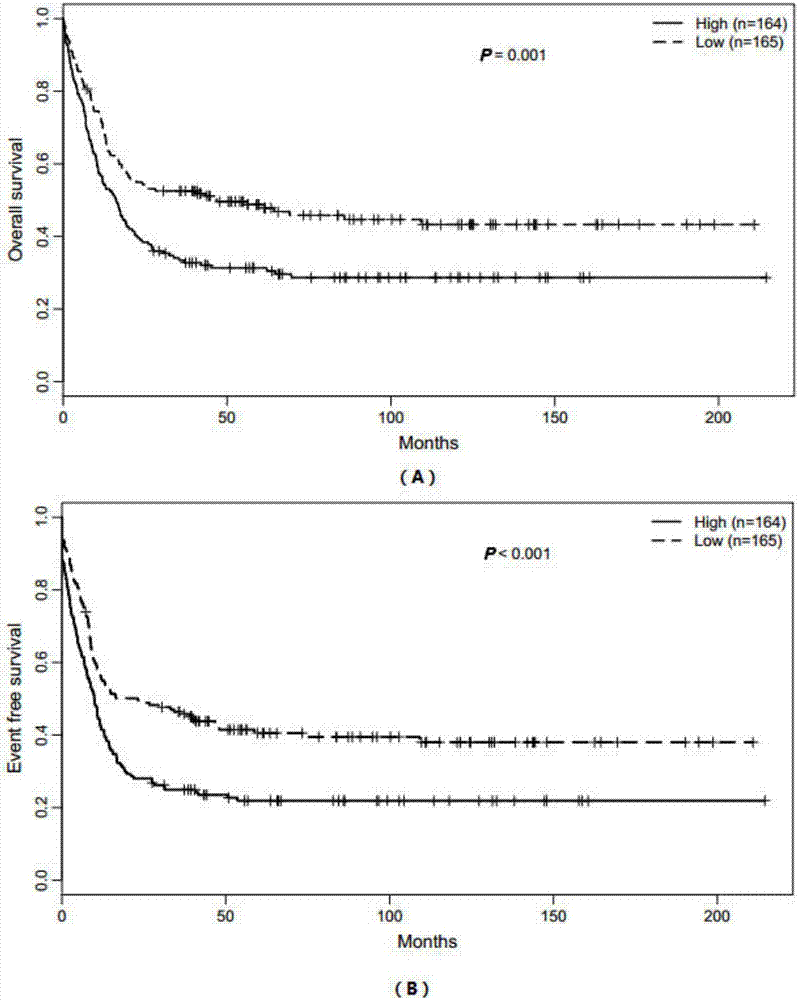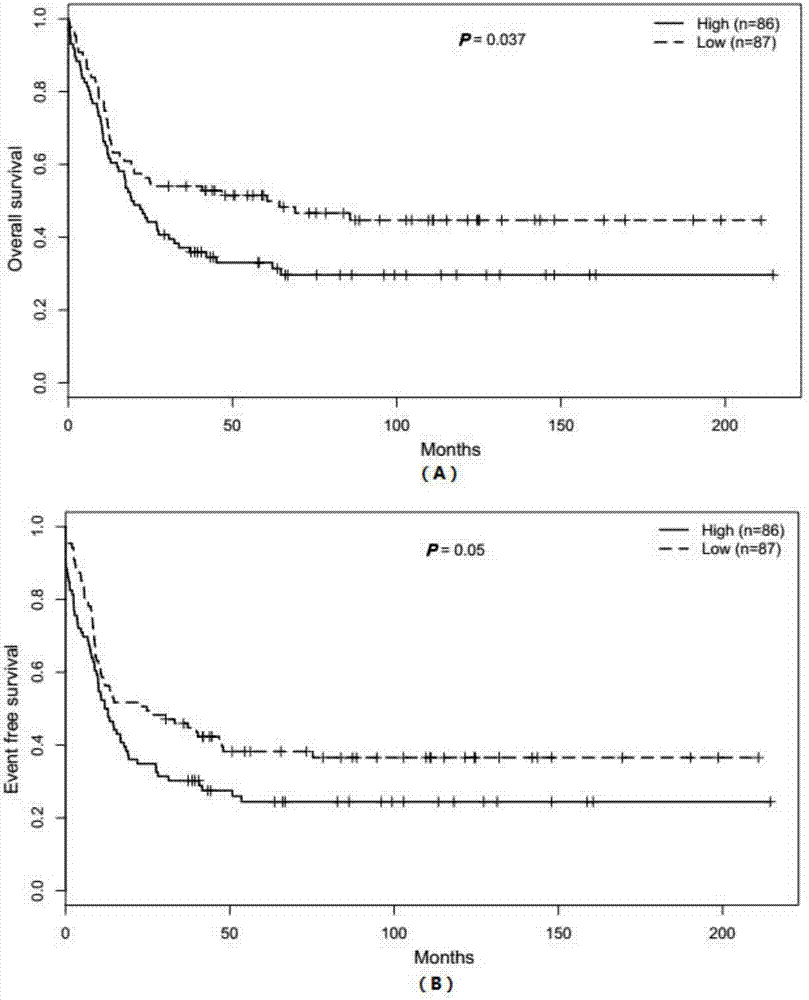Detection kit for precision diagnosis and treatment of acute myelogenous leukemia and TSEN34 clinic application
A technology for acute myeloid and leukemia, which is applied in the determination/examination of microorganisms, recombinant DNA technology, DNA/RNA fragments, etc., which can solve the problems of stratified diagnosis of AML and the difficulty and lack of individualized treatment.
- Summary
- Abstract
- Description
- Claims
- Application Information
AI Technical Summary
Problems solved by technology
Method used
Image
Examples
Embodiment 1
[0065] Example 1 Differential expression of TSEN34 gene in adult acute myeloid leukemia patients and normal CD34+ cells
[0066] Data set: Data of 77 AML patients using Illumina BeadChip Arrays (HT12v3) chips.
[0067] 1. Collect the bone marrow tissues of the patients and screen each tissue sample for CD34+ cells. A total of 46 cases of adult acute myeloid leukemia patients with CD34+ cells were obtained.
[0068] 2. Collect bone marrow tissues from normal people and screen CD34+ cells for each tissue sample as a negative control. A total of 31 CD34+ cells from healthy volunteers were obtained.
[0069] 3. Use Illumina BeadChip Arrays (HT12v3) to detect the expression level of TSEN34 gene in the CD34+ cells of 46 adult patients with acute myeloid leukemia and 31 normal people. The results are as follows figure 1 .
[0070] Results: The median expression of TSEN34 gene in CD34+ cells of 46 adult patients with acute myeloid leukemia was 10.9, and the median expression of TSEN34 gene in C...
Embodiment 2
[0071] Example 2 Screening of genes related to diagnosis and prognosis evaluation of adult acute myeloid leukemia
[0072] Data set: Use Affymetrix Human Genome U133Plus 2.0Array chip to obtain genome-wide expression profile data of 344 cases of acute myeloid leukemia (AML) with follow-up information.
[0073] The Affymetrix Human Genome U133Plus 2.0 Array chip was used as the screening object. There were a total of 344 adult acute myeloid leukemia patients' gene expression profile experimental data in the chip. Analyze and integrate through R language to find genes related to the diagnosis and prognosis of acute myeloid leukemia.
[0074] Based on the median gene expression value of the entire patient sample population, the adult acute myeloid leukemia patient samples were divided into two groups. Patients with higher than the median value were defined as the group with high expression of the gene, and those below the median value Patients were defined as a group with low expressio...
Embodiment 3
[0075] Example 3 Extraction of total RNA
[0076] 1. Collect 5ml of patient's bone marrow, place it in EDTA anticoagulation tube, add FicoII-Hypaque Lymphocyte Separator, and extract mononuclear cells by density gradient centrifugation.
[0077] 2. Lysis of cells: Add 1ml of QIAZOL reagent to the collected cell pellet, shake with a shaker and mix well, and let it lyse fully at room temperature for more than 15 minutes. If RNA cannot be extracted immediately after adding QIAZOL reagent, it can be stored at -20°C for short-term use.
[0078] 3. According to the chloroform:QIAZOL volume ratio of 1:4, add about 300μl of chloroform, mix upside down for 1 minute, let stand at room temperature for 5-10 minutes, low-temperature centrifugation: 4℃, 12600rpm for 10 minutes.
[0079] 4. After centrifugation, the liquid in the EP tube is divided into three layers, the upper layer is the supernatant containing RNA, and the middle and lower layers are DNA and protein. Then, transfer the supernatan...
PUM
 Login to View More
Login to View More Abstract
Description
Claims
Application Information
 Login to View More
Login to View More - R&D
- Intellectual Property
- Life Sciences
- Materials
- Tech Scout
- Unparalleled Data Quality
- Higher Quality Content
- 60% Fewer Hallucinations
Browse by: Latest US Patents, China's latest patents, Technical Efficacy Thesaurus, Application Domain, Technology Topic, Popular Technical Reports.
© 2025 PatSnap. All rights reserved.Legal|Privacy policy|Modern Slavery Act Transparency Statement|Sitemap|About US| Contact US: help@patsnap.com



